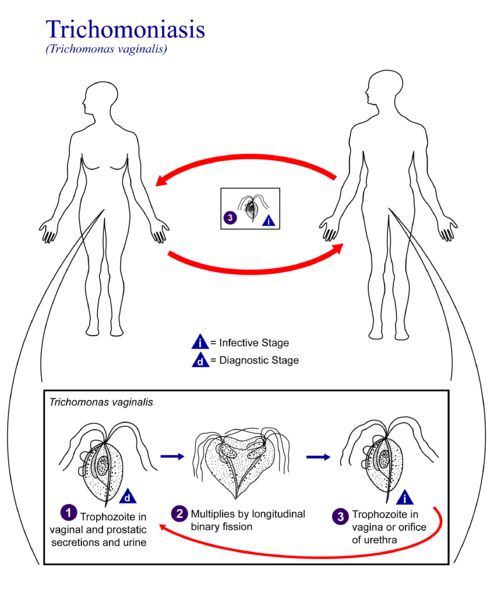 |
| Trichomoniasis |
Trichomoniasis is caused by a protozoan (the smallest, single-celled members of the animal kingdom). Trichomonas vaginalis is almost always passed through sexual contact. Trichomoniasis is primarily an infection of women’s vaginal and urinary tracts. A woman is most susceptible to infection just after having completed her menstrual period.
Men may carry the organism unknowingly, since infection in men may cause mild or no symptoms. Men may also experience urethral discharge or persistent urethritis. Trichomoniasis is associated with HIV transmission and may be associated with adverse pregnancy outcomes.
  |
Causes and symptoms
Because trichomoniasis is a sexually transmitted disease, it occurs more often in individuals who have multiple sexual partners. The protozoan is passed to an individual by contact within the body fluids of an infected sexual partner. It often occurs simultaneously with other sexually transmitted diseases, especially gonorrhea.
In women, the symptoms of trichomoniasis include an unpleasant vaginal odor, and a heavy, frothy, yellow discharge from the vagina. The genital area (vulva) is often very itchy, and there is frequently pain with urination or with sexual intercourse.
 |
| protozoan Trichomonas vaginalis |
In men, there may be no symptoms at all. Some men notice a small amount of yellowish discharge from the penis, usually first thing in the morning. There may be some mild discomfort while urinating, testicular pain or tenderness, or lower abdominal pain. Some men infected with trichomoniasis experience persistent urethritis.
The use of antibiotics is a contributing factor to recurrent trichomoniasis in some women because antibiotics affect the balance of bacteria in the vagina, allowing such organisms as T. vaginalis to multiply more rapidly.
Diagnosis
Diagnosis is easily made by taking a sample of the discharge from the woman’s vagina or from the opening of the man’s penis. The sample is put on a slide and viewed under a microscope. The protozoa, which are able to move about, are easily viewed.
Trichomoniasis tends to be underdiagnosed in men because of the relative mildness of symptoms in men and insufficiently sensitive diagnostic tests. The recent introduction of DNA amplification, however, indicates that the incidence of trichomoniasis in men is much higher than was previously thought.
Treatment
Cure of trichomoniasis may be difficult to achieve with alternative treatments. Some practitioners suggest eliminating sweets and carbohydrates from the diet and supplement with antioxidants, including vitamins A, C, and E, and zinc. Naturopaths may recommend treatment with two douches (a wash used inside the vagina), alternating one in the morning and one at bedtime.
One douche contains the herbs calendula (Calendula officinalis), goldenseal (Hydrastis canadensis), and echinacea (Echinacea spp.); the other douche contains plain yogurt with live acidophilus cultures. The herbal douche helps to kill the protozoa while the yogurt reestablishes healthy flora in the vagina. Tea tree oil is another alternative remedy for trichomoniasis.
Acidifying the vagina by douching with boric acid or vinegar may also be useful. Although not a cure, The Gynecological Sourcebook suggests inserting a garlic (Allium sativum) suppository (a peeled whole clove wrapped in gauze) every 12 hours for symptomatic relief.
Other remedies include vaginal suppositories that include the ingredient acidophilus once a day for three days. An alternative medicine practitioner can recommend the correct mixture. A vaginal douche consisting of grapefruit seed extract may also help relieve symptoms.
Allopathic treatment
 |
| It is spread through sex |
The usual treatment is a single large dose of metronidazole (Flagyl) or split doses over the course of a week. Some sources suggest clotrimazole (Gyne-lotrimin, Mycelex) as an alternative treatment showing a lower cure rate.
Application of Betadine, a concentrated antiseptic solution, is another recommendation, although Betadine is messy, stains, and should not be used by pregnant women. However, the Centers for Disease Control (CDC) states that there are no effective alternatives to therapy with metronidazole available. Topical treatment with metronidazole is not advised.
Individual evaluations are recommended for those who are allergic to metronidazole or who experience treatment-resistant trichomoniasis. Sexual partners of an infected individual must all be treated, to prevent the infection from being passed back and forth. Sexual intercourse should be avoided until all partners are cured.
  |
As of late 2003, the number of cases of metronidazole-resistant trichomoniasis appears to be increasing rapidly. Some success has been reported with the broadspectrum anti-parasitic drug nitazoxanide, but further research needs to be done.
A group of researchers in Thailand is currently investigating the effectiveness of a group of drugs known as bisquaternary quinolinium salt compounds in treating trichomoniasis.
Women who are taking antibiotics for other illnesses should speak to their health care provider about the possibile effects of the medication(s) on the balance of organisms in their vagina.
Expected results
 |
| sexually transmitted diseases |
Prevention
All sexually transmitted diseases can be prevented by using adequate protection during sexual intercourse. Effective forms of protection include male and female condoms. Other preventive measures are similar to those for other forms of vaginitis, including wearing loose cotton clothing and not using douches, vaginal deodorants, or sprays.